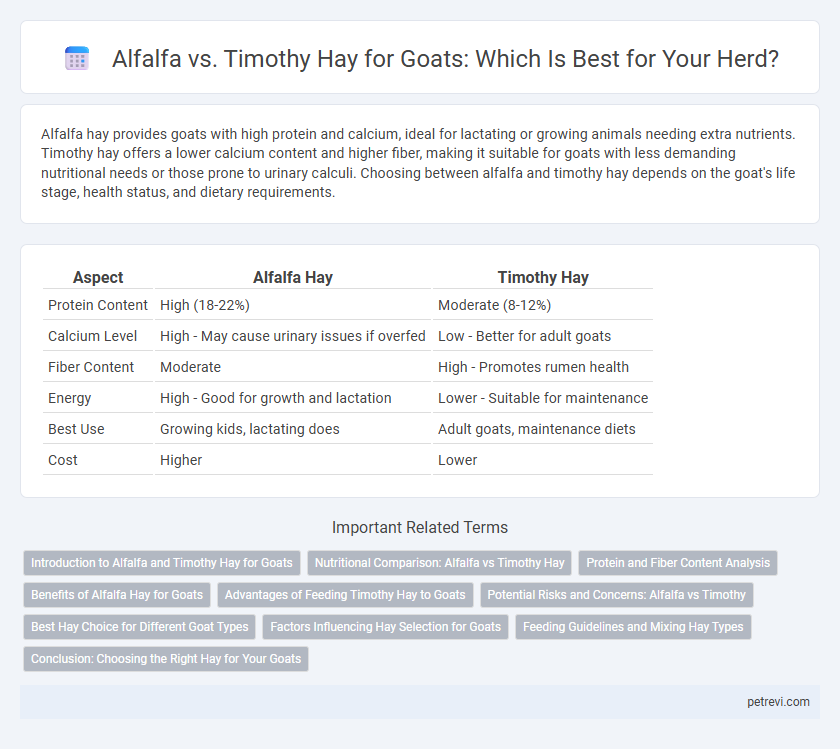Alfalfa hay provides goats with high protein and calcium, ideal for lactating or growing animals needing extra nutrients. Timothy hay offers a lower calcium content and higher fiber, making it suitable for goats with less demanding nutritional needs or those prone to urinary calculi. Choosing between alfalfa and timothy hay depends on the goat's life stage, health status, and dietary requirements.
Table of Comparison
| Aspect | Alfalfa Hay | Timothy Hay |
|---|---|---|
| Protein Content | High (18-22%) | Moderate (8-12%) |
| Calcium Level | High - May cause urinary issues if overfed | Low - Better for adult goats |
| Fiber Content | Moderate | High - Promotes rumen health |
| Energy | High - Good for growth and lactation | Lower - Suitable for maintenance |
| Best Use | Growing kids, lactating does | Adult goats, maintenance diets |
| Cost | Higher | Lower |
Introduction to Alfalfa and Timothy Hay for Goats
Alfalfa and Timothy hay are two popular forage options for goats, each offering distinct nutritional profiles essential for different needs. Alfalfa hay is rich in protein, calcium, and energy, making it ideal for lactating does, growing kids, and high-producing animals. Timothy hay provides a high-fiber, lower-calorie alternative, suitable for maintenance diets and overweight or adult goats requiring controlled energy intake.
Nutritional Comparison: Alfalfa vs Timothy Hay
Alfalfa hay contains higher protein and calcium levels than Timothy hay, making it ideal for lactating or growing goats requiring enhanced nutritional support. Timothy hay offers greater fiber content with lower protein, suitable for adult goats needing maintenance nutrition and promoting healthy digestion. Balancing alfalfa and timothy hay based on the goat's life stage optimizes dietary needs and overall health outcomes.
Protein and Fiber Content Analysis
Alfalfa hay contains higher protein levels, typically ranging from 15% to 22%, making it ideal for growing or lactating goats, while timothy hay has lower protein content, usually around 8% to 12%, suited for maintenance diets. Fiber analysis shows timothy hay possesses greater neutral detergent fiber (NDF), often 60% to 70%, which promotes optimal rumen function and slower digestion. Balancing alfalfa's rich protein with timothy's high fiber provides goats with a nutritious diet that supports health, growth, and milk production.
Benefits of Alfalfa Hay for Goats
Alfalfa hay offers high protein content and rich calcium levels essential for muscle development and strong bone health in goats. Its digestible fiber enhances gut health, supporting efficient nutrient absorption and overall vitality. Compared to Timothy hay, alfalfa provides a nutrient-dense option that promotes faster growth rates and improved milk production in lactating does.
Advantages of Feeding Timothy Hay to Goats
Timothy hay offers advantages for goats due to its high fiber content, promoting healthy digestion and preventing issues like bloat. It contains lower calcium levels compared to alfalfa, reducing the risk of urinary calculi in male goats. The balanced nutrient profile of Timothy hay supports optimal weight maintenance without excessive protein, ensuring overall goat health and longevity.
Potential Risks and Concerns: Alfalfa vs Timothy
Alfalfa hay, while rich in protein and calcium, poses potential risks such as urinary calculi in male goats due to its high calcium content, increasing the likelihood of bladder stones. Timothy hay, with lower protein and calcium levels, presents fewer concerns related to metabolic imbalances but may lack sufficient nutrients for lactating or growing goats. Monitoring dietary balance and providing adequate water intake is essential to mitigate health issues associated with both alfalfa and timothy hay feeding.
Best Hay Choice for Different Goat Types
Alfalfa hay, rich in protein and calcium, is ideal for lactating or young growing goats that require higher nutrient intake for optimal health and production. Timothy hay, lower in protein and calcium but higher in fiber, suits adult maintenance goats and those prone to obesity or urinary calculi, promoting healthier digestion. Selecting between alfalfa and timothy hay depends on the goat's age, production status, and specific dietary needs to ensure balanced nutrition and overall well-being.
Factors Influencing Hay Selection for Goats
Hay selection for goats depends heavily on nutritional content, digestibility, and fiber length, with alfalfa offering higher protein and calcium levels compared to timothy. While alfalfa promotes rapid growth and lactation due to its rich nutrient profile, timothy hay is preferred for mature or overweight goats because of its lower calorie content and coarser texture. Seasonal availability, goat age, and health conditions further influence the choice between alfalfa and timothy hay to ensure optimal digestion and overall animal well-being.
Feeding Guidelines and Mixing Hay Types
Alfalfa hay offers high protein and calcium levels ideal for lactating or growing goats, but should be balanced with Timothy hay to prevent excessive calcium intake that can lead to urinary calculi. Mixing 30-50% alfalfa with 50-70% Timothy provides a well-rounded diet, promoting optimal fiber intake and digestive health. Feeding guidelines recommend adjusting the ratio based on the goat's age, production stage, and health status to meet specific nutritional requirements.
Conclusion: Choosing the Right Hay for Your Goats
Alfalfa hay offers higher protein and calcium content essential for lactating and growing goats, while Timothy hay provides balanced fiber ideal for maintenance and adult goats prone to weight gain. Selecting the right hay depends on your goats' specific nutritional requirements and life stages, ensuring optimal health and productivity. Incorporating both types in rotation can help maintain dietary variety and overall wellbeing.
Alfalfa vs Timothy for Goat hay Infographic

 petrevi.com
petrevi.com